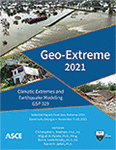Impacts of Extreme Landslide Dam Event on the Yarlung Tsangpo Basin
Publication: Geo-Extreme 2021
ABSTRACT
The Yarlung Tsangpo River Grand Canyon is the most precipitous place in the Yarlung Tsangpo River, has a length of 504.6 km, a slope of 0.155%, and a valley bottom elevation difference of 2,755 m. Evidence shows the Yarlung Tsangpo River as well as its tributaries are frequently blocked by landslides, avalanches, and debris flow. The breaching of some large landslide dams, such as the 2000 Yigong landslide dam and the 2018 Gyalha landslide dam, resulted in huge floods and impacted large downstream areas. This paper reports a method to analyze the breaching flood of landslide dams in different locations on the Yarlung Tsangpo River Grand Canyon. The method can be divided into two steps: first, a physical model is used to predict the breach outflow rate of the landslide dam at the prone points in the basin; second, hydraulic software is used to simulate breach outflow rate and flood routing process downstream of the dam. A digital model is composed of the Yarlung Tsangpo River and two of its tributaries are built for this purpose. The results show that the simulated peak discharge at dam sites and corresponding outflow rate along rivers agree well with field observations. The peak outflow rate is amplified when breaching floods of landslide dams on the mainstream and its tributaries are overlapped. The method proposed in this paper can be effectively applied to breaching flood evolution of landslide dams.
Get full access to this article
View all available purchase options and get full access to this chapter.
REFERENCES
Chang, D. S., and Zhang, L. M. (2010). “Simulation of the erosion process of landslide dams due to over-topping considering variations in soil erodibility along,depth.” Natural Hazards and Earth System Sciences. 10(4), 933–946.
Chang, D. S., Zhang, L. M., Xu, Y., and Huang, R. Q. (2011). “Field testing of erodibility of two landslide dams triggered by the 12 May Wenchuan earthquake.” Landslides. 8 (3), 321–332.
Chen, C., Zhang, L., Xiao, T., and He, J. (2020). “Barrier lake bursting and flood routing in the Yarlung Tsangpo Grand Canyon in October 2018.” Journal of Hydrology. 583, 124603.
China Daily. (2018). http://cn.chinadaily.com.cn/2018-10/20/content_37107081.htm.
CCTV News. (2018b). http://m.news.cctv.com/2018/10/20/ARTIjyNKpGkVwHdXQd5JjZSY181020.shtml.
Costa, J. E., and Schuster, R. L. (1988). “The formation and failure of natural dams.” Geological Society of America bulletin. 100(7), 1054–1068.
Davies, T. R., Manville, V., Kunz, M., and Donadini, L. (2007). “Modeling Landslide Dambreak Flood Magnitudes: Case Study.” Journal of Hydraulic Engineering. 133(7),713–720.
Fread, D. L. (1984). DAMBRK: The NWS dam-break flood forecasting model. Washington, D.C: National Weather Service, NOAA.
Han, Z. S. (2003). “Large scale landslide-debris avalanche in Tibet, China (1) April-June 2000 Yigong landslide, Tibet China.” Landslide News. 14-15, 22–23.
Jin, X. P. (2019). “Reviews and reflections on emergency response countermeasures for barrier lakes in Jinsha River and Yarlung Zangbo River.” Yangtze River. 50 (3), 5–9.
Li, B., Gao, Y., Wan, J. W., Liu, Z., Gao, H. Y., Wei, T. Y., and Li, Z. (2020). “The Chain of the Major Geological Disasters and Related Strategies in the Yalu-Zangbu River Canyon Region.” Hydropower and Pumped Storage. 6(2), 11–14.
Omid, R., Abdolreza, B., Nader, N., and Micah, M. (2019). “Evaluating flood extent mapping of two hydraulic models, 1D HEC‐RAS and 2D LISFLOOD‐FP in comparison with aerial imagery observations in Gorgan flood plain, Iran.” Natural resource modeling. 32, e12214.
Peng, M., and Zhang, L. M. (2012). “Breaching parameters of landslide dams.” Landslides. 9(1), 13–31.
Shang, Y., Yang, Z., Li, L., Liu, D., Liao, Q., and Wang, Y. (2003). “A super-large landslide in Tibet in 2000: background, occurrence, disaster, and origin.” Geomorphology. 54, 225–243.
Turzewski, M. D., Huntington, K., and Leveque, R. J. (2019). “The Geomorphic Impact of Outburst Floods: Integrating Observations and Numerical Simulations of the 2000 Yigong Flood, Eastern Himalaya.” Journal of Geophysical Research: Earth Surface. 124(5), 1056–1079.
Tewari, P. (2004). “A study of soil erosion in Pasighat town (Arunachal Pradesh) India.” Nat. Hazards. 32, 257–275.
Walder, J. S., and O’Connor, J. E. (1997). Methods for predicting peak discharge of floods caused by failure of natural and constructed earthen dams. Water Resources Research. 33(10), 2337–2348.
Zhou, J., Cui, P., and Hao, M. (2016). Comprehensive analyses of the initiation and entrainment processes of the 2000 Yigong catastrophic landslide in Tibet, China. Landslides. 13(1), 39–54.
Information & Authors
Information
Published In
Copyright
© 2021 American Society of Civil Engineers.
History
Published online: Nov 4, 2021
Authors
Metrics & Citations
Metrics
Citations
Download citation
If you have the appropriate software installed, you can download article citation data to the citation manager of your choice. Simply select your manager software from the list below and click Download.
